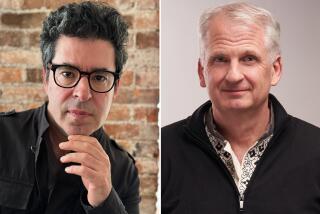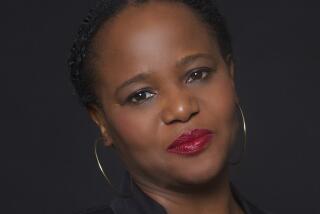Review: Where Malcolm X meets the Marquis de Sade: Olivia Laingâs intense new essays on freedom
On the Shelf
Everybody: A Book About Freedom
By Olivia Laing
Norton: 368 pages, $27
If you buy books linked on our site, The Times may earn a commission from Bookshop.org, whose fees support independent bookstores.
Olivia Laingâs fifth work of nonfiction, âEverybody: A Book About Freedom,â is a compendium of echoes. The approach recalls much of her spirited nonfiction work: âThe Trip to Echo Spring,â which traces the link between alcohol and the work of writers such as F. Scott Fitzgerald, John Berryman and Raymond Carver; or âThe Lonely City,â an examination of urban loneliness through the lens of artists Henry Darger and David Wojnarowicz, among others.
With âEverybody,â Laing also invokes an array of voices, including Susan Sontag and Kathy Acker, Philip Guston and Nina Simone and the Marquis de Sade. She writes movingly and at length about discredited psychoanalyst Wilhelm Reich â he of the steel-lined orgone box â who died in 1957 at Pennsylvaniaâs Lewisburg Federal Penitentiary after years of persecution by the Food and Drug Administration.
In Laingâs formulation, freedom is capacious, but it also has its limits, and these begin and end with the body. âFreedom isnât simply a matter of indulging all material cravings, Sade-style,â she observes. âItâs also about finding ways to live without being hampered, hobbled, damaged or actively destroyed by a constant reinforcement of ideas about what is permitted for the category of body to which youâve been assigned.â
For Laing, the body is fluid, always in a state of becoming. By way of illustration, she writes about such artists as Agnes Martin, who refused to acknowledge sexuality or gender (âIâm not a woman, Iâm a doorknob,â she once said), and Ana Mendieta, the creator of a series of images called Siluetas, in which the full-size impression of a womanâs body was pressed into the earth and then filled with âpigment or flowers or blood.â She also incorporates pieces of her own autobiography.
The novelist and essayistâs slim new collection, âIntimations,â probes our COVID-19 reality as well as her own gifts, blind spots and vulnerabilities.
The point is to highlight the vulnerability of the body, which, paradoxically or otherwise, is also the source of its power. Laing quotes Acker, who died in 1997 at age 50 (and whom Laing channeled, controversially, in her novel âCrudo.â) âMy search for a way to defeat cancer now became a search for life and death that were meaningful,â Acker once wrote. For her, Laing elaborates, âa meaningful body was a far richer source of freedom than health itself.â
Laing is seeking a strategy to unravel our binary thinking about physicality: life or death, liberty or confinement, health or disease. Only by looking beyond these dualities, she insists, can we begin to understand what freedom means. In that sense, the bookâs title makes for an instructive play on words. On the one hand, it is universal, âeverybodyâ as a synonym for âeveryone.â On the other, it is highly individual â every body, as in hers or yours or mine. The body is what we have in common as well as what sets us apart. Embodied, we live in proximity to one another yet remain fundamentally alone.
Never is this clearer, Laing suggests, than when we are sick or imprisoned, made other by the status of our body in the most pragmatic terms. Thatâs why the Acker story is enlightening; it implies a freedom that might seem unimaginable to most of us: the freedom to die.
Laing is defining freedom as an inside game; even if we may not always control what happens to our bodies, we can have agency in our minds. As an example, she cites Malcolm X, who in the late 1940s, as an inmate at the Norfolk Prison Colony in Massachusetts, âbecame a reader, driven by his frustration at being unable to convey and discuss [Elijah] Muhammadâs astounding teachings with the limited street slang he possessed.â He copied out every word and definition in the dictionary until he âfelt truly emancipated by knowledge.â The project was all-consuming. âMonths passed without my even thinking about being imprisoned,â Malcolm would later remember. âIn fact, up to then, I never had been so truly free in my life.â
Such a process recalls Vaclav Havel and his notion of second culture, articulated in the context of another hostile environment, that of a totalitarian regime. âIndividuals,â Havel reasons in his 1978 essay âThe Power of the Powerless,â âcan be alienated from themselves only because there is something in them to alienate. The terrain of this violation is their authentic existence. Living the truth is thus woven directly into the texture of living a lie.â
The plot of the slim novel âCrudoâ concerns an âIâ who, like author Olivia Laing, has recently become engaged to a much-older poet and is planning their wedding celebration during the chaotic world of 2017.
Havelâs argument is that we all make choices about our freedom, even (or especially) when it is curtailed. Only we can imprison ourselves â an idea Laing explores in âEverybodyâ as well. One hero of the book is civil rights activist Bayard Rustin, arrested in 1945 as a conscientious objector after writing to his draft board that â[t]hough joyfully following the law of God, I regret I must break the law of State. I am prepared for whatever might follow.â Another is Edith Jacobson, a colleague of Reichâs in Berlin who, imprisoned by the Gestapo, smuggled a paper about the effects of imprisonment on women to a friend to present at a psychoanalytic conference.
Even De Sade, who wrote mostly in confinement, ends up, in Laingâs analysis, âless driven by misogyny than [by] the problem of the incarcerated body itself.â This is a daring and complicated take, and Laing develops it throughout the book. âSadeâs novels,â she writes, âare about being able to gratify desire, yes, but theyâre more powerfully animated by a compulsion to punish the body for needing anything at all.â In the end, she asserts, â[i]tâs not just that prison is sadistic; itâs that the historical concept of sadism was born in a prison cell.â
To reach such a conclusion, Laing begins with the work of Andrea Dworkin, who considered De Sade a âsexual terrorist, ⌠rapist and writer twisted in one scurvy knot.â She admires Dworkinâs thinking but ultimately turns away from her point of view. More useful is Angela Carter, whose 1979 book âThe Sadeian Womanâ contends that De Sadeâs writings âpeel back the myth of liberty, exposing the multiple ways in which any individualâs sexual or political freedom depends upon the servitude and abasement of others.â As Carter explains, âOne of Sadeâs cruelest lessons is that tyranny is implicit in all privilege. My freedom makes you more unfree, if it does not acknowledge your freedom, also.â
Here we see the method of âEverybody,â framed as an extended conversation between the author and her sources, in which De Sade blurs into Reich, who blurs into Sontag, and back again. The key to all this movement is that it also invites us to participate in the conversation â a conversation that changes as âEverybodyâ progresses, reflecting the fluidity Laing investigates.
â[W]e live whether we like it or not in the object world,â she writes, âsharing the resources of reality with billions of other beings. There is no steel-lined box that can protect you from the grid of forces that limits in tangible, tormenting ways what each private body is allowed to be or do.â Freedom then begins in the imagination, with the decisions we each must make about how we engage. âThere is no escape, no possible place to hide,â Laing cautions. âEither you submit to the world or you change the world.â
âSecond Place,â Rachel Cuskâs first novel after the radical, brilliant âOutlineâ trilogy, follows a forceful woman whoâs had enough of difficult men.
Ulin is a former book editor and book critic of The Times.
More to Read
Sign up for our Book Club newsletter
Get the latest news, events and more from the Los Angeles Times Book Club, and help us get L.A. reading and talking.
You may occasionally receive promotional content from the Los Angeles Times.







